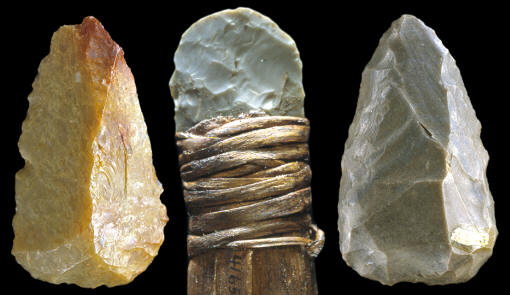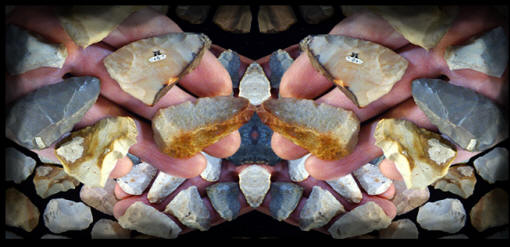|
"(An
end scraper is a) Narrow blade tool
with a convex working edge at one or both ends."-----1973,
Francois Bordes, "The Old Stone Age," p. 243.
"The end scraper (grattoir
terminal) is widely known from the beginning of the upper Paleolithic
period."---1970,
S. A. Semenov, "Prehistoric Technology, An Experimental Study Of
The Oldest Tools And Artifacts From Traces Of Manufacture And Wear,"
p. 85.
"Nearly all the (upper) Paleolithic assemblages we
have examined have end scrapers, made on either flakes or blades, and
for the most part their forms are not distinctive."---2012,
Dennis J. Stanford & Bruce A. Bradley, "Across Atlantic Ice, The
Origin Of America's Clovis Culture" p. 164.
"As a class, scrapers are the most common
shaped tools in Paleo-Indian assemblages."---1990,
Richard Michael Gramly, "Guide To The Paleo-Indian Artifacts Of
North America," p. 49.
"A major category
of Folsom implements is the end scraper. These tools rank fifth in
frequency and are typologically the most sensitive Folsom indicators
after projectile points."---1972,
James J. Hester, Ernest L. Lundelius, Jr. & Roald Fryxell, "Blackwater
Locality No. 1, A Stratified, Early Man Site In Eastern New Mexico," p.
125.
"(A
scraper is) A flaked stone tool,
often made on a flake or blade, having bold unifacial retouch on one or
more margins."---1990,
Richard Michael Gramly, "Guide To The Paleo-Indian Artifacts Of
North America," p. 49.
"Late Paleolithic, characterized by blade
industries, (are)
often associated with such artifact forms as end-scrapers, burins, and
awls."---1988,
Ian Tattersall, Eric Delson & John Van Couvering, "Encyclopedia Of
Human Evolution And Prehistory," p. 547.
"Although there is
evidence of use on several of these spurs (on
end scrapers) from Excavation area 8
(on the Gault site, Texas)
it is likely that spurs on end scrapers originally resulted from
modification of the haft element and resharpening of the bit while the
scraper was in the haft."---2011,
Michael R. Waters, Charlotte D. Pevny & David L. Carlson, "Clovis Lithic
Technology, Investigation Of A Stratified Workshop At The Gault Site,
Texas," p, 126.
"Implements of the scraper class
are indispensable adjuncts of the arts of life among primitive peoples."---1912,
Frederick Webb Hodge, "Handbook Of American Indians North Of
Mexico, Part 2," p. 489.

END-SCRAPERS
WORLDWIDE
40,000 YEARS AGO TO RECENT TIMES
Scrapers are one of the most common tool forms that have been found on
Stone Age sites around the world. They are objects of utility that can
be compared with such things as knives, gouges, adzes, spades, etc. Each of these different tool forms can be
separated into different types. End scrapers represent one of the many
different types of scrapers.
|
|
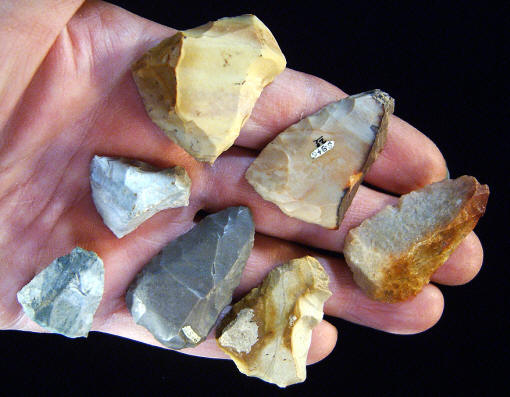
END-SCRAPERS
BOSTROM SITE
CLOVIS CULTURE
ST. CLAIR COUNTY, ILLINOIS
These end scrapers were surface collected on the
Bostrom Clovis site
located in St. Clair County, Illinois. They represent typical
examples of early period Paleo Indian scrapers. The scraper at far
right is made of Kaolin chert and measures 1 3/4 inches (4.4 cm)
long. |
|
|
End scraper is the most commonly used term to describe these simple
tools but they have also
been referred to as transverse and distal edge tools. Or even as grattoir
terminal in European terminology. End scrapers might also be described
as a multipurpose tool, for example, a "combination end scraper/burin."
There are also double end scrapers that have scraping edges on both ends
of the blade. |
|
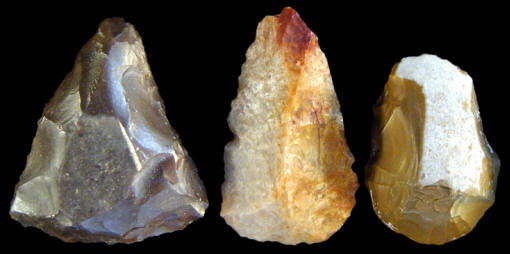
CLICK ON PICTURE FOR LARGER IMAGE
END SCRAPERS FROM THREE
COUNTRIES
SAUDI
ARABIA, NORTH AMERICA AND SWITZERLAND
NEOLITHIC AND CLOVIS CULTURE
Each of these three end scrapers were
collected on widely separated sites around the world but they all
represent the same tool form. They are all made of good quality fine
grained chert and have a triangular or tear-drop shape. The widest
ends are represented by steeply sharpened scraping edges. The
example on the left was found on a Neolithic site in Saudi Arabia.
The end scraper in the center was collected on the Bostrom Clovis
site in southern Illinois. The example on the right was collected on
a Swiss Lake site in Switzerland.
The end scraper in the center is made of Kaolin chert and measures 1
3/4 inches (4.4 cm) long. |
|
|
End scrapers are simple unifacial tools that were finished by
pressure flaking from one side only. Next to common
un-modified flakes, unifacial tools represent the largest group of tool
forms that were made by Stone Age cultures during the Upper Paleolithic
period. |
|
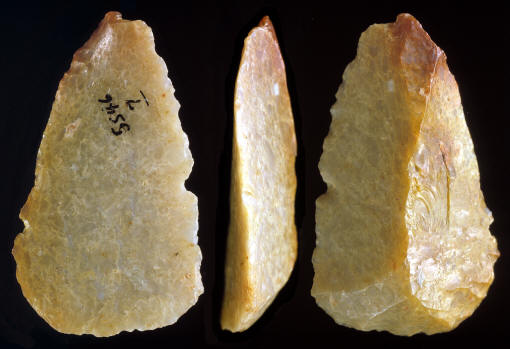
CLICK ON PICTURE FOR LARGER IMAGE
END-SCRAPER
BOSTROM SITE
CLOVIS CULTURE
ST. CLAIR COUNTY, ILLINOIS
This
end scraper was surface collected on the Bostrom Clovis site in St.
Clair County Illinois. It has the "classic" tear-drop shape. The
thickest area in the cross section is represented by the working end
and the thinnest is the hafting end. There is only a very slight
protuberance at the narrow end that indicates a bulb-of-percussion.
The edge is also very sharp, indicating it
probably had very little use. This end scraper is
made of Kaolin chert and it measures 1 3/4 inches (4.4 cm) long. |
|
|
Most end
scrapers are either triangular or tear drop in shape. The working edge,
with the exception of double end scrapers, is usually the thickest area
of the tool and located opposite the bulb-of-percussion. End scrapers
were made from blades and flakes by removing small flakes around the
edges from one side with pressure. Sometimes the bulb-of-percussion was
removed opposite the working edge to thin the hafting area. |
|
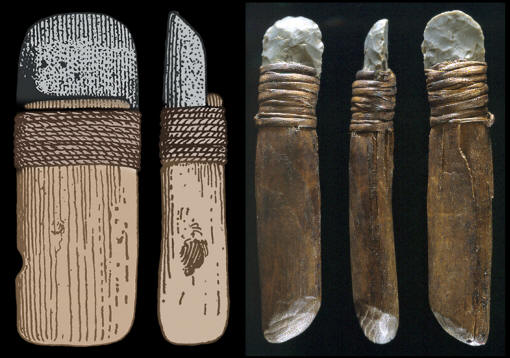
Drawing on left from Smithsonian 1912
"Handbook Of American Indians North Of
Mexico," and the
hafted end scraper on the right is in the collection of the
Smithsonian Institution.
CLICK ON PICTURE FOR LARGER IMAGE OF SCRAPER AT RIGHT
HAFTED END-SCRAPERS
INUIT
This picture shows
how some Inuit Eskimo end scrapers were hafted onto handles. The
drawing on the left was taken from the Smithsonian 1912 Handbook of
American Indians and
it represents a "central Eskimo scraper." The example on the right is a Thule tradition hafted scraper
that was found on the Walakpa site in Alaska. It
was made in Alaska approximately 600 years ago. The wood handle and fiber
hafting material is perfectly preserved. It measures 4 7/8 inches
(12.4 cm) long. |
|
|
It is generally believed that end scrapers were hafted onto
short handles. In fact, a good percentage of stone artifact tool forms
were once hafted onto handles or spear and arrow shafts. On the Hell Gap
Cody Complex site in Wyoming, evidence of hafting abrasive wear was
observed on some of the end scrapers. Many examples of hafted end
scrapers are known from the Inuit Eskimo and Plains Indian bison
hunters. A handle offers the tool user better leverage to press against
the material being scraped. |
|
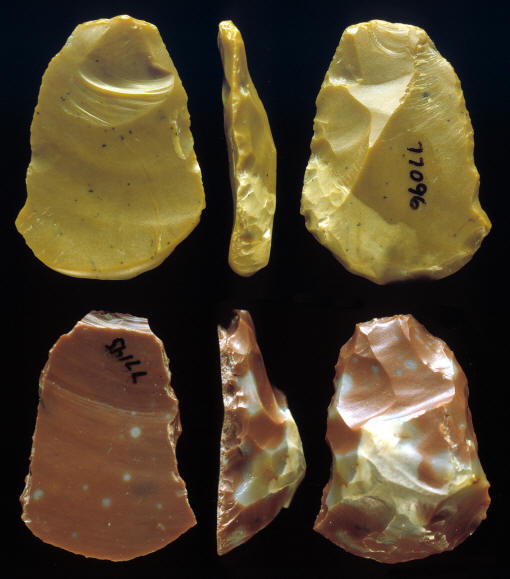
CLICK ON PICTURE FOR LARGER IMAGE
END SCRAPERS
HORNER
SITE
CODY COMPLEX
PARK
COUNTY, WYOMING
Both of these end scrapers were found
during the excavation of the Horner site in Parker County, Wyoming.
The Horner site is the representative type site for the Cody
Complex. Both of these end scrapers are made of good quality fine
grained cherts. They have been shaped into a basic tear-drop shape
by removing flakes along the edges with pressure. The example at the
top is interesting for the fact that much of the bulb-of-percussion
was removed, apparently to thin it further for hafting. This scraper
is also interesting for its heavily used and extremely smoothed
scraping edge. It may have been discarded as no longer useful. The
working edge on the scraper on the bottom is sharp and it has a
sharp point on one corner. The end scraper on top
measures 1 1/4 inches (3.1 cm) long. |
|
|
End scraper handles were made from several different materials. Many of
the Inuit handles were made from bone with the scrapers hafted at the
end. Plains Indian bison hunters hafted most of their scrapers onto
L-shaped handles made from elk antler and some with wood. Some early
handles were made of mammoth ivory. |
|
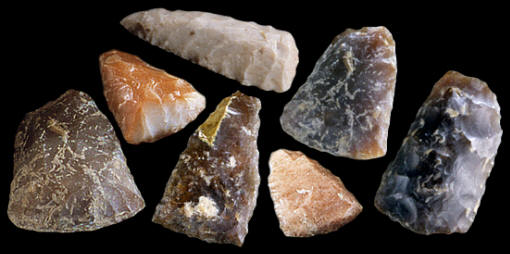
END-SCRAPERS
MITCHELL SITE
SOUTHEASTERN SOUTH DAKOTA
A.D. 1,000
These scrapers were discovered during the excavation of the Mitchell
site in southeastern South Dakota. The people who once lived there were farmers who were growing
corn, beans, and squash. They were also
hunting large numbers of deer and bison. So it's likely that some of
these end scrapers were used as skin dressing tools to
clean hides of excess flesh, fat and muscle fiber. |
|
|
End scrapers are mainly a product of core and blade technology. So it's
not surprising that they first appear during the Late Paleolithic period
with the introduction of blade technology. This occurs sometime between
35,000 and 40,000 years ago. End scrapers continued to be used in some isolated and more primitive cultures until
very recent times. |
|
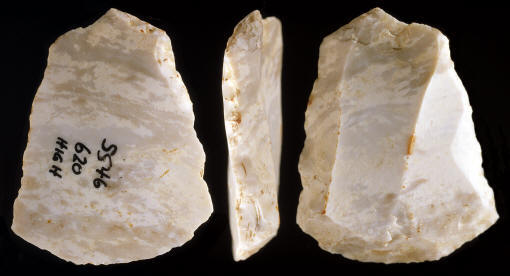
CLICK ON PICTURE FOR LARGER IMAGE
CLOVIS POINT
BOSTROM
SITE
CLOVIS CULTURE
ST. CLAIR COUNTY, ILLINOIS
This end scraper was surface
collected on the Bostrom Clovis site in St. Clair County in southern
Illinois. It's a typical example. The large parallel sided flake
removal scar across one side is good evidence that this end scraper
may have been made from a blade that was produced from a prepared
core. There is one sharp point on one end of the working edge that
some people might identify as a spur. This scraper is made of white
Burlington chert. |
|
|
End scrapers were used to process and shape softer organic
materials such as animal hides, antler, bone, and wood. But their most
common use may have been for scraping animal
hides. Plains Indian bison
hunters were using end scrapers as skin dressing tools to clean buffalo
hides of excess flesh, fat and muscle fiber. Eskimo cultures were also
using hafted end scrapers to process skins for clothing, boats, tents,
dog harnesses, etc. Primitive cultures around the world have used end
scrapers to process all types and sizes of animal hides. |
|
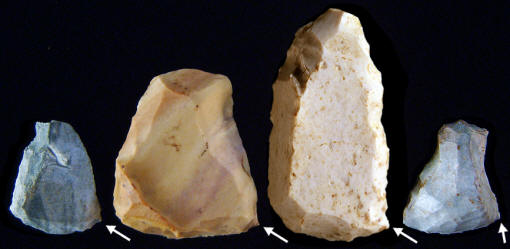
CLICK ON PICTURE FOR LARGER IMAGE
SPURRED END SCRAPERS
BOSTROM SITE
CLOVIS CULTURE
ST. CLAIR COUNTY, ILLINOIS
These four end scrapers were found on
the Bostrom Clovis site in St. Clair County, Illinois. The arrows
point to a small corner points or spurs that is evident on at least one
corner of each working edge. Some or all of them may have been
formed only as a result of resharpening. The third example from the
left has the longest projection and it does seem to show some use
wear. The longest scraper is made of Burlington chert and
measures 1 7/8 inches (4.7
cm) long. |
|
|
End scrapers were made from all types of stone that could be flaked.
Like any other tool form they were made from both good and poor quality
stone. The best materials are fine grain highly siliceous cherts. But
end scrapers have been made out of obsidian, quartzite, and
different types of non-siliceous materials that could be flaked. |
|
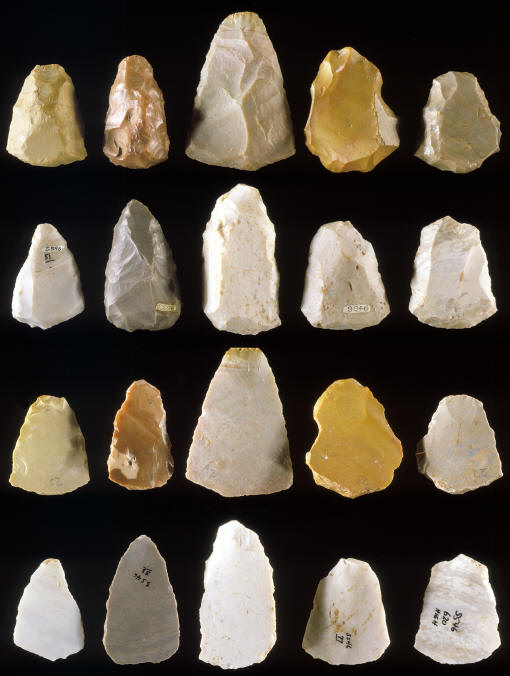
CLICK ON PICTURE FOR LARGER IMAGE
END SCRAPERS
BOSTROM SITE
CLOVIS CULTURE
ST. CLAIR COUNTY, ILLINOIS
This picture shows both sides of ten
examples of Clovis culture end scrapers that were found on the
Bostrom site in St. Clair County, Illinois. They represent typical
examples. Most of them have a tear-drop shape and the widest end is
the working edge. The scraping edges are convex and some of them
have a sharp corner that might be referred to as a spur. The lower
two rows clearly show that they were all unifacial tools that were
made on either flakes, or blades that were struck from prepared cores. The
scraper in the center of the second row is made of Burlington chert
and
measures 1 7/8 inches (4.7
cm) long. |
|
|
Some end scrapers have spurs that are located on the corners of the
working edge. Most of them seem to be reported from early Paleo Indian and Solutrean tool assemblages in North America
and Europe. Some of the sharp pointed corner edges and small pointed
graver-like projections that are observed on end scrapers were probably
formed as a result of resharpening. But other spurs seem to have use wear on them. Their
exact purpose is still being investigated. |
|
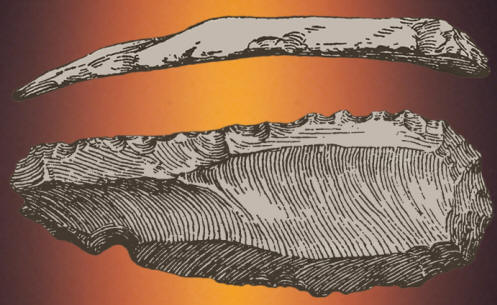
ILLUSTRATION FROM SMITHSONIAN
THIRTEENTH ANNUAL REPORT
OF THE BUREAU OF ETHNOLOGY 1891-1892
EARLY ILLUSTRATION OF END-SCRAPER
This picture shows a drawing of one
of the earliest illustrations of an end scraper. It was published in
the 13th edition of the 1891-1892 Annual Report of the Bureau of
Ethnology. The drawing illustrates a scraper that was probably made
from a core blade. It has a convex working edge that is located at
the thickest area of the blade and it has a tear-drop shape. All
indications are that this tool was probably meant to represent an end
scraper. |
|
|
End scrapers are one of the most common and basic tool forms
that were ever invented by humans. Objects like screw drivers and pliers
seem like old and common tools to people in the modern world. But they
don't hold a candle to end scrapers that have been around for 40,000
years. |
|
"REFERENCES"
1896, Fowke, Gerard, "Stone Art,"
13th Annual Report of the Bureau
of Ethnology, p. 173.
1912, Hodge, Frederick Webb "Handbook Of American Indians North Of
Mexico, Part 2," p. 489.
1970, Semenov, S. A. "Prehistoric Technology, An Experimental Study Of
The Oldest Tools And Artifacts From Traces Of Manufacture And Wear,"
p. 85.
1972,
Hester, James J., Lundelius, Ernest L. Jr. & Fryxell, Roald, Blackwater
Locality No. 1, A Stratified, Early Man Site In Eastern New Mexico," p.
125.
1973, Francois, Francois "The Old Stone Age," p. 243.
1988, Tattersall, Ian, Delson, Eric, & Couvering, John Van,
"Encyclopedia Of Human Evolution And Prehistory," p. 547.
1990, Gramly, Richard Michael, "Guide To The Paleo-Indian Artifacts
Of North America," p. 49.
2011, Waters, Michael R., Pevny, Charlotte D. & Carlson, Davis
L., "Clovis Lithic
Technology, Investigation Of A Stratified Workshop At The Gault Site,
Texas," p, 126.
2012, Stanford, Dennis J. & Bradley, Bruce A. "Across Atlantic Ice,
The Origin Of America's Clovis Culture" p. 164.
|
|
RECENT
LISTINGS HOME
ORDERING |
